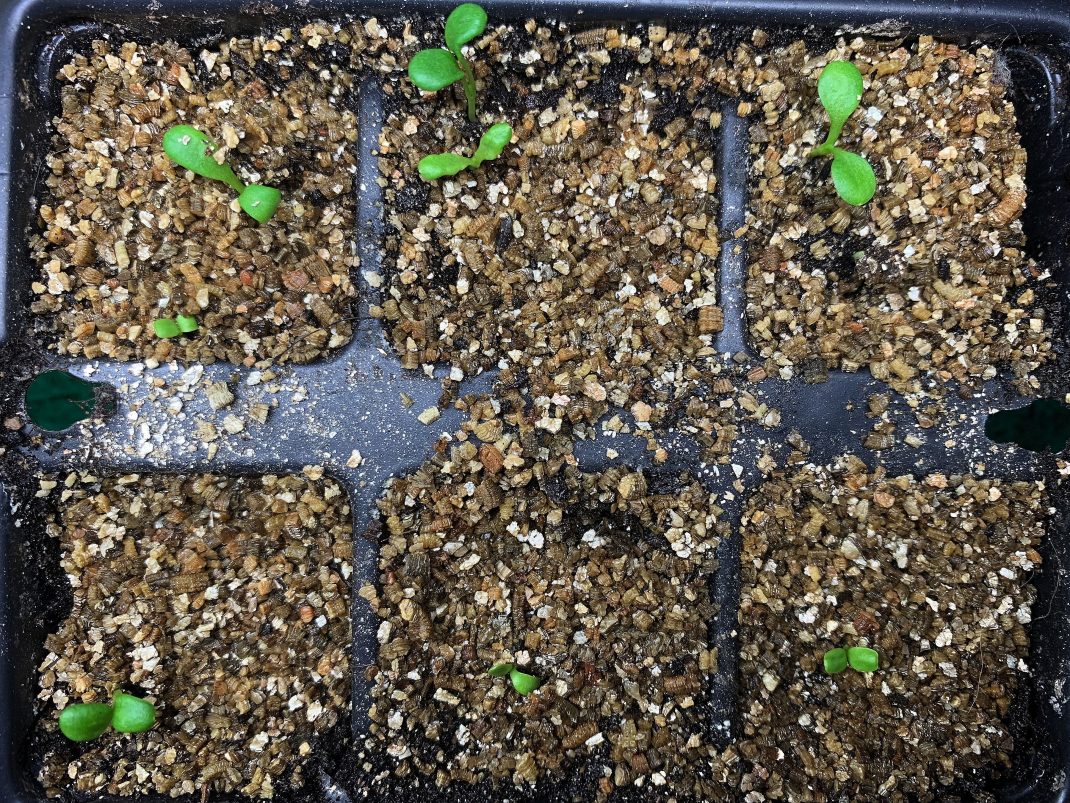Vermiculite - How to use it in the garden
Do you need some extra help with your indoor sowings? Why not give vermiculite a try. I go through everything you need to know about the handy mineral in this post.

I put my seeds right on the soil here in this trough with six cells, and then I covered them with vermiculite.
What is vermiculite and how on earth are you supposed to use it? I know that a lot of gardeners out there ask these questions, or maybe they haven't even heard the name before. That's why I wanted to write a bit more about this at least to me, fascinating subject!
What is vermiculite?
You might come to think about vermicompost or anything related to earthworms when you hear the word vermi. But vermiculite has nothing to do with worms. So, what is it then? Well, it's actually a mineral! A heat-treated mineral that looks a little like fool's gold. The vermiculite is unlike the fool's gold (which is embedded in rock) very light. It's basically light as air and shimmers, and comes in very small little shards. Seasoned gardeners buy it in large stock and of course we use it for the beds in our gardens. You can find vermiculite in larger garden shops and of course, online.
Some of you homeowners out there might just recognize this material. A similar type of vermiculite is actually used as a filler when constructing chimneys. That material comes in larger pieces though.

This is what the bag looks like. I just close the bag up and leave it next to the potting soil.
How to use vermiculite
You can use this material for plenty of different tasks and purposes in your garden. The most common way to use it is probably to put it on top of sowings. I think it's a great way to support extra sensitive seeds. But I'm getting away with myself. Let me explain:
Early sowings are often put under a grow light indoors, preferably also on top of a heat mat to get the seeds to grow quickly. If the seeds are left in cold soil too long, some of them might not be able to grow and the sowing might get completely destroyed. Sensitive seeds sown in relatively shallow soil (or maybe even sown on top of the soil) are especially vulnerable since the top layer of soil can dry out. The soil can dry out easily even without the grow light on top.
More about growing vegetables indoors: Grow pea shoots indoors
So in these cases, it really helps to cover the little seeds and the top layer of soil with a material that keeps the soil from drying out. The material needs to be light enough to allow the tiny little seedlings to come through. That's why we want to use vermiculite.
Vermiculite reflects light too, which means that some of the light hitting the material is actually directed downwards, to the soil. Light-germinating seeds grow a lot easier with the help of vermiculite, rather than a thin layer of soil on top.
Some people mix their vermiculite into their soil too, in order to get nice and airy soil for their vulnerable sowings. You can usually tell what kind of soil the plants need by reading the back of the seed packet.

New sowings on a heat mat. I took the lid off to take the picture, it stays on the rest of the time though. This helps keep the heat and moist locked in, which means that the sowings don't dry out as easily.
My vermiculite sowings
Right now, I'm sowing plenty of summer flowers and perennials. I basically sow all of my seeds on top of the soil, cover with vermiculite and then I put them in a little trough filled with water to water them from underneath. After that, I put my sowing in a different trough on top of a heat mat and underneath a grow light too of course. Here are some of my vermiculite sowings this year:
- black-eyed Susan
- wild thyme
- queen-of-the-alps
- great masterwort
- Russian sage
Questions
How much should I use?
A thin layer is all you need. I usually take a handful and just scatter it on top of my sowing. I sometimes cover the soil already before sowing, and then add a thin layer on top afterwards too.
Is it expensive?
Not at all! I got a 1 gallon (4 liter) bag for 6.5 dollars (65 Swedish crowns, or 6 Euro.) This amount of vermiculite will get you far too.
Can you use it outdoors?
Yes! I use mine to cover plenty of different sowings, for example in my plug trays too. Like I mentioned before though, I especially like using vermiculite for vulnerable sowings where I suspect that the soil might dry out. I don't use it for my beds or pallet collars outside though.
I just wanted to add that you don't of course have to get vermiculite to be successful in the garden. Some think it's a bit too advanced for them. I do however think that it's a great tool to protect your seeds, and it saves me some headache in the garden. I think it's especially valuable this year, when we don't have that much space for sowings at home and I need to move even very small plants to Oak Hill Cottage.
/Sara Bäckmo
* I'm only using potting soil for my indoor sowings this year. The main reason is strictly practical, since it's so convenient to keep my potting soil in a little box filled with gardening tools in my living room. It's so easy to just get some and then put it right back when I'm done. I use regular store-bought planting soil for my winter and spring sowings outdoors though.
06. April 2020


Leave a Reply
You must be logged in to post a comment.